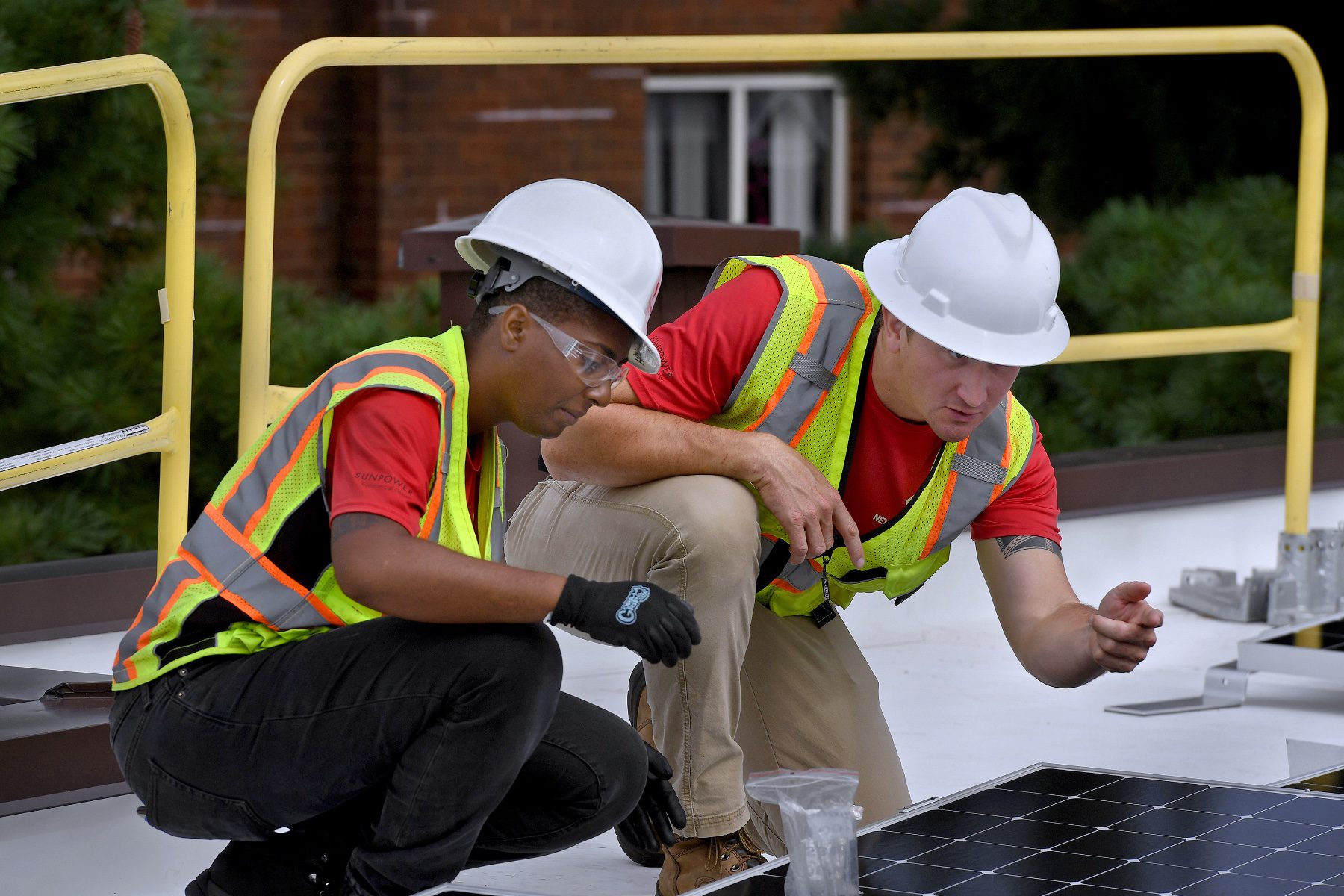When Anna Bautista was studying electrical engineering at the Massachusetts Institute of Technology, she didn’t know she would soon find herself chasing a career in the fledgling solar industry.
But after college, she went on a trip to her family’s homeland, the Philippines, on a tour organized by the Filipino/American Coalition for Environmental Solidarity, an organization that addresses environmental justice issues. There, she says, she met with community leaders who were fighting against oil depots, mining and logging companies and U.S. military dumps, among other extractive industries.
“I returned stateside to the belly of the beast, inspired to change our energy infrastructure in a way that benefits the communities that matter the most to me,” she said. So, she committed to a career path in solar construction.
In 2005, she enrolled at Solar Energy International (SEI), a nonprofit based in rural Colorado where participants could learn the basics of a solar installation — one of the few solar training programs at the time. For five weeks she took courses in design and installation, rural electrification and solar businesses and was part of a program specifically for women, where she said she was lucky to find a supportive group of mentors she’s leaned on throughout her career.
“The whole, ‘If you see it you can be it,’ I’ve had that through my whole journey in solar,” Bautista said. “Even though I’m a smaller-bodied, femme-presenting person in construction, I just was able to have a network that I could turn to and that also believed I could be successful in the industry.”
After the training, she moved to San Diego for her first job digging trenches for solar installations, and eventually worked her way into solar design and project management for a solar installation company. Now, as the vice president of construction for GRID Alternatives, the largest nonprofit solar installer in the country, she’s part of an effort to make the industry more accessible to women. Through a network of nonprofits and tradeswomen groups, women are fostering networking opportunities for the next generation, creating better workplaces for mothers and training men in the field to be allies against harassment.
The energy sector and the myriad trades like construction and electrical work needed to transition the country to clean energy have long been dominated by men, who make up 70 percent of the solar industry workforce, according to the latest employment numbers released by the Department of Energy.
Women are disproportionately facing the impacts of the climate crisis: They are more likely to be displaced by climate disasters, and due to lower-paid jobs, caregiving responsibilities and the wage gap, they have less economic means to recover and adapt to a changing climate. Bringing women into jobs in fields like solar and wind, which are projected to grow rapidly, could help offset some of the economic inequality caused by the rising costs of climate-attributed disasters.
“There is the equity aspect where you want to ensure that women, especially women of color, who are more often the primary breadwinners … have access to [these] family sustaining jobs,” said Marina Zhavoronkova, a senior fellow at the Center for American Progress.
Though U.S. employment in solar dropped during the pandemic, accounting for approximately 231,000 jobs, it is projected to grow to 400,000 jobs by 2030, according to the 2020 National Solar Jobs Census.
For decades, women have been working to carve out a safe space for themselves in the field. The first women’s solar training at SEI, for example, was created in 1999 after the institute noticed that only one or two women were joining their co-ed training. They wondered if creating a comfortable learning environment where people felt able to ask questions and learn about solar in a space without men would increase women’s attendance.
“We wanted to see if we could attract more women to our workshops,” said Justine Sanchez, a curriculum designer at SEI who helped craft those first training sessions, in an email. “So really, it was somewhat of an experiment to see if offering a women’s-only version would bring them in. And it absolutely did.”
They’ve since offered women’s wind-power workshops and carpentry classes. And this year, the institute launched a new Women in Solar Program in partnership with SOLV Energy, a solar energy company, to provide bilingual solar energy training, networking opportunities and access to mentors.
“Having this training only for women really creates that environment that not only you’ll feel comfortable and safe asking any questions, but also you start creating this strong network of women that will be supporting each other as well,” said María Pía Day, who helped launch the program. “Any people in this industry should have a safe environment to grow their careers regardless of gender, ethnicity, nationality and race,” she added.
Other women-in-solar trainings have also launched at GRID Alternatives, where Bautista works, and mentorship has sprouted up in the industry from organizations like the nonprofit Women of Renewable Industries and Sustainable Energy, which works to bring women together in national networking events and funds fellowships for women in solar and wind development.
Creating a pipeline and developing an inclusive workforce is only one aspect of bringing more women into the industry, Zhavoronkova said. “There’s a lot of work to be done on the retention side,” she said. “You can’t recruit people into a profession where they will be likely to leave.”
The trades have historically been a hostile workplace for women, and in some industries like construction, women make up just four percent of workers. For Bautista, retaining women goes back to addressing issues like workplace harassment and discrimination. “There is work that is not mine to do and that I can’t do,” she said. “And that is specifically to address the culture among men in the construction industry.”
Her organization is looking to bring in a trainer from a Canadian organization that created a “Be More than a Bystander” training aimed at teaching men in the trades how to help end gender-based bullying and harassment on the job. The three-day training was developed after a 2017 report showed that a “toxic culture of gender-based bullying and harassment in the industry” was partially to blame for retention challenges among women and other underrepresented genders in the trades in Canada.
“The bystander training will be huge,” Bautista said. Micro-aggressions and harassment are common in the industry, she added. As an example, sometimes “on job sites people go to shake hands with my subordinate first,” she said. Her employee usually has to point out that she is, in fact, the boss.
“Then there is the bro culture of like a woman walks into a room and a culture or energy in the room shifts. … It has a feeling of exclusion where folks then feel themselves shrink.” This can cause an internalized imposter syndrome, she said: “All these micro-aggressions lead to where women-identified folks start putting limitations on themselves in terms of competence even if they are super competent.”
Another barrier is access to child care. Bautista, who gave birth during the pandemic, said she’s the only person on the construction team who has a young child.
“As an executive I have a lot of privilege, I can do flexible scheduling, I can work from home.” she said. “[But] if you’re out on site it is much more rigid.”
Zhavoronkova said finding care can be a logistical and costly challenge for people working in construction. “For a lot of these larger projects, the hours are not traditional,” she said. “So you need to basically find child care that opens really early in the morning, which is difficult.”
According to a report released by the Institute for Women’s Policy and Research, in a 2018 survey of construction apprentices, around 45 percent of mothers and 26 percent of fathers said that both the cost and ability to find consistent child care was a barrier. Work days often occur outside of the typical scope of child care centers, which generally open at 7 a.m.
There have been some recent pilot programs to provide child care for caregivers who are working on construction sites, including a project announced in April by North America’s Building Trades Union and the Tradeswomen Committee, that will provide child care access on a job site in Milwaukee.
After the bipartisan Infrastructure Investment and Jobs Act passed last November, a $1 trillion bill that will pay for road and bridges, as well as electric vehicle chargers and grid improvements, the National Taskforce on Tradeswomen’s Issues released a statement requesting that infrastructure funds be designated for child care costs, among other needs.
“If we want the industry to be successful, we have to think about that,” Bautista said. “I’ve never had so much rage in my body before becoming a mom as to how institutionally there is no support and structurally there is no support for mothers and caregivers.”







